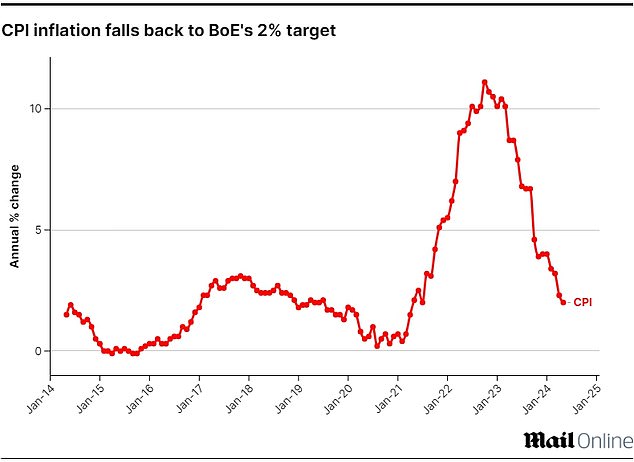House prices are officially rising again, ONS says, as inflation falls below target
House prices have risen higher for the second month in a row, according to the latest figures from the Office of National Statistics.
In April the average house sold for £281,000, up 1.1 per cent on twelve months ago.
This was an increase of 0.9 percent in the 12 months to March, marking the second month in a row to record an annual increase after eight months of declines.
– Is a mortgage with a fixed term of five years the best option now because the interest rate remains high?
On the rise: average house prices increased by 1.1 percent in the twelve months to April 2024
Richard Harrison, head of mortgages at Atom Bank, thinks so a clear sign of improved optimism among buyers.
“Potential buyers are more confident about going through with transactions,” Harrison says.
Nicky Stevenson, director of national estate agents group Fine & Country, agrees.
She said: ‘The weather was blamed for the flattening of the economy in April, but rain did not dampen buyer sentiment, while house prices remained resilient.
‘After so many buyers halted their home purchase plans towards the end of 2023, stable interest rates and the prospect of a reduction this summer were enough to inspire confidence, and many people have committed to making a move.’
Today’s house price figures come amid news that inflation has fallen back to the Bank of England’s 2 percent target.
This means that the average price of goods and services is now 2 percent higher than last year.
The hope is that the Bank of England will soon consider cutting interest rates, which could lead to lower mortgage rates.

Inflation watch: Inflation has reached the Bank of England’s 2% target. It is the first time since July 2021 that inflation has reached this level
Nicky Stevenson added: ‘Reports this morning show that the consumer price index is now in line with the government’s target to keep inflation under control.
‘As we expect the economic landscape to continue to improve, it is likely that we will see a peak in activity over the course of the year, especially with a Bank of England rate cut on the horizon.
“This would positively impact homebuyers by making mortgages more affordable, increasing consumers’ purchasing power and helping them get their desired properties more easily.”
Nathan Emerson, CEO of Propertymark, added: ‘With the tide finally turning on inflation, attention is now firmly focused on when the Bank of England feels confident enough to start cutting rates. the basic interest rate.
“Once this journey begins and the political landscape settles down after the general election, we should see a stable market in the near future.”
Data on house prices are lagging behind
The main problem with the ONS house price data is that it is dependent on the sales price data from the Land Registry.
This means that the figures generally refer to sales agreed months in advance.
Jonathan Hopper, CEO of Garrington Property Finders, said: ‘Today’s figures reflect the aftermath of the strong increase in activity at the start of the year.
“Many of the sales completed in April are the result of deals closed in January and February, when there were no buyers and the market was booming.
‘So while today’s data is more than a little sepia-tinted, its resilience is still welcome.
‘At a national level, it appears that the market is stabilizing considerably: the number of houses changing ownership in April increased by almost 10 percent in April compared to the same month last year.’
When we look at more immediate indicators of what’s happening in the real estate market here and now, it’s easy to get a mixed message.
The housing market has gone into reverse again, according to the latest research from the Royal Institution of Chartered Surveyors (Rics).
It said new buyer demand moved further into negative territory last month, the lowest level since November.
This means that more Rics members reported fewer buyer inquiries in May than those who reported an increase in inquiries.

According to the Rics survey, new buyer inquiries saw a dip, alongside a general weakening of sales market momentum
However, according to Propertymark, agent members reported 16 percent more buyers registered with agents in April than in March.
Atom Bank’s Harrison added: ‘While there are mixed messages about the market’s immediate prospects, brokers are registering with them, at a faster pace than the increase in supply, and that is driving prices higher.
‘This is reflected in a higher level of activity, with brokers seeing the number of agreed sales increase to the highest level in two years.
House prices in the regions
Although prices generally increase year-on-year, prices vary widely by region.
For example, house prices in Scotland have risen by 4.5 percent in the past twelve months, while in Northern Ireland the average home has risen by 4 percent.
In the English regions, house price increases were greatest in the North West, where prices rose by 3.8 percent in the 12 months to April.
In London, however, prices have fallen by an average of 3.9 percent year-on-year.
The only other region where house prices fell in the 12 months to April is the South East, where average prices are 0.4 per cent lower.
“Wide regional disparities remain as the high cost of mortgage lending forces many buyers to focus their search on more affordable areas,” said Jonathan Hopper of Garrington Property Finders.
‘That’s why average prices have risen by 3.8 per cent in North West England and fallen by 3.9 per cent in London over the past year.’
Some links in this article may be affiliate links. If you click on it, we may earn a small commission. That helps us fund This Is Money and keep it free to use. We do not write articles to promote products. We do not allow a commercial relationship to compromise our editorial independence.

